The re-re-emergergence of Carignan(e) the semi-public eye has returned!
While I do not have any legal claim to the Carignan Renaissance name, I do support the concept that this variety is capable of creating wonderful, site-evocative wines with exceptional balance and beauty.

This thread is for fellow-minded wine lovers to share their love and support for this truly unique grape.
Following.
Foundation Plant Services “Carignan(e)” Profile:
“This grape variety originated in the province of Aragón in northeast Spain near the town of Cariñena. The variety was known in Spain as Mazuela, Mazuelo, and Cariñena. The grape was so widely cultivated in France that it has come to be identified with that country under the name Carignan (Carignan noir). The variety is known as Carignane in the United States.”
Out of personal custom, I will continue to refer to the grape as “Carignan”. Others are free to spell the variety as they choose.
As you may know, many growers refer to it as “Kerrigan”. The Irish grape! ![]()
Drew, we need to make you into a Johnny Appleseed type of character. Instead of apple trees you can plant neglected grape varieties all throughout California.
Here are two articles focusing on Californian (and some French) Carignan, both written by Jon Bonné. Apologies for the fact that the content is older…and not always flattering of the grape.
SF Gate
“Carignane Gets a Shot at Respect - Quietly”
by Jon Bonné
August 1, 2010
"The story of Carignane is the story of a down-and-outer, a Jake LaMotta. It is that most unloved of grapes - planted nearly everywhere, almost regrettably so, and respected almost nowhere.
"This is unfair. One of the world’s most widely available grapes, Carignane has become a virtual synonym for nondescript. But when cared for and restrained from prolific growth, old Carignane vines offer a wine that combines beautiful bright fruit with a spicy edge (think celery seed) and a slight wild, animal tone. It is the frizzy-haired cousin to mellow Grenache or sharp-tongued Syrah.
"Now there’s a blip of resurgence for Carignane as a source for affordable, complex wine - though you might not even know it’s Carignane in the bottle.
"…‘Carignane might be representative of something less aristocratic,’ speculates Randall Grahm of Bonny Doon Vineyard, one of California’s great Carignane proponents, ‘and so it needs to be repressed.’
"Story about survivors
"But ours is a story about survivors - vines that have endured through the decades to make compelling wines.
"…Gnarled Carignane vines can be located in places like Mendocino’s Redwood Valley and Contra Costa County. Often more than 50 years old, and in some cases dating back more than a century, these are remnants of California’s era of ‘mixed black’ grapes and jug wine. A solid performer like Carignane won favor with farmers.
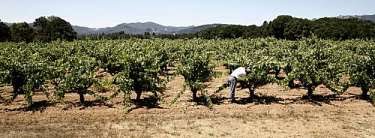
"Farmers like the Finnish ancestors of Alvin Tollini, who grows Carignane vines that are more than 60 years old, in Redwood Valley, northeast of Ukiah. Vines first went in around the time Tollini’s grandfather was born in 1915. The vine louse phylloxera forced replanting; the wizened old trunks on the property date back to 1948.
"‘I think most of the growers in that area had Carignane, and maybe a bit of Zinfandel,’ Tollini says. ‘That’s what everybody grew in those days,’ often selling them to large concerns like Gallo.
"Fortunes in Europe
"…Throughout southwest France, noble old specimens of Carignan thrive. In the Roussillon region, in the towns of Maury and Belesta, Eric and Leia Monné use Carignan in two momentous reds under their Clot de l’Oum label.
"In the Languedoc, a Carignan renaissance can be detected in Corbieres, where Maxime Magnon makes a delicate bottling that reflects his tutelage in Beaujolais under Jean Foillard. Nearby in Minervois, a stronghold for low-grade Carignan, Burgundian couple Anne Gros and Jean-Paul Tollot are bringing refined winemaking from Vosne-Romanee to sunnier climes. In Saint-Chinian, Jean-Marie Rimbert has acquired an international reputation for attempting to elevate Carignane grown on schist soils to the status of Pinot.
Still, the grape has plenty of detractors, including writer Jancis Robinson, who famously wrote that its ‘wine is high in everything - acidity, tannins, colour, bitterness - but finesse and charm.’
"Its fortunes were never so grim in California, though they have been mixed. Grape researcher Eugene W. Hilgard noted in an 1896 report: ‘The results obtained with this grape in different localities of California are somewhat discordant. In a few specially suitable localities it has produced a good wine, while in most others the wine is only from fair to poor.’
"Patience required
"If Carignane is a neutral workhorse, when placed in talented hands it can produce at least an interesting wine - and an affordable one. Slow to ripen or lose its acidity, mostly it requires patience.
"Even in late October it can be picked without being too ripe, providing ample freshness - which is why old Carignane vines from 1882 and 1892 still form ‘the backbone of our Geyserville,’ says David Gates, Ridge Vineyards’ vice president for vineyard operations. Or why it is abundant in the warmest parts of Dry Creek and Alexander valleys, interplanted as a way to freshen up ripe Zinfandel.
"‘That’s why the old-timers planted that way,’ Gates says. ‘They knew what they had in the Carignane.’
"Grahm discovered something similar, inadvertently. Growers forced him to take Carignane to get other grapes when buying fruit for his popular Big House red among the old vines of Contra Costa County (also the source for a robust Carignane from Cline). With Carignane as its backbone, Big House became so popular that Grahm spun it off in 2006.
"Endangered resource
"Kevin Kelley, who makes the Lioco wines, sees old-vine Carignane as an endangered resource…Even if the old vines can make excellent wine, they don’t necessarily earn enough money to remain in the ground.
"‘These vines won’t be there anymore because people can’t live off them,’ Kelley says of the growers. ‘They’re going to farm the land, and if Carignane won’t pay the bills, Chardonnay at $800 a ton will.’
"Chris Brockway of Broc Cellars in Berkeley found a similar tale with an Alexander Valley vineyard near Cloverdale. Though its Carignane vines, up to 120 years old, had been used by Ridge for its Oat Valley Vineyard bottle, the fruit had few takers in recent years.
"‘I think I was at the end of a string of people they talked to, to see if I was interested,’ he says. ‘They were considering pulling out this vineyard and planting Cabernet.’
"Brockway liked how the vines seemed to grow balanced fruit despite heat spikes and drought. To offset the usual complaints about the grape, he decided to make his initial 2009 vintage much as it’s done in Minervois, using carbonic maceration - like with Beaujolais - that lets grapes ferment inside their own skins, rather than being crushed. That adds spice from grape stems but keeps the tannins soft and the fruit flavors sweeter. (He compares it to ice pops.)
"Flavors can be a barrier
"Carignane’s flavors, ultimately, can be a big barrier. Wines like Indica have been well received, often because no one knows it’s Carignane in the glass. But the flavors can be so neutral that winemaker Sean Thackrey once compared it to ‘sweetwater,’ while more distinct examples show off darker root and earth flavors, and sometimes greenness, that dominate the bright fruit.
"‘I call it the cilantro of grape varieties,’ Grahm says. ‘It creates a bifurcated reaction, either people like it a lot … or they don’t like it a lot. Maybe there’s a taste receptor, like with cilantro.’
"One other little glitch: Really good Carignane comes from vines at least a half century old. Who can wait that long for a vineyard to mature?
"And how many of those old vines will even survive? It’s not a concern unique to Carignane. Throughout Russian River Valley, old field-blend vineyards are making way for Pinot Noir (natch) and tract houses.
"But great old Carignane, at least in California, is about more than economics. Kelley compares it to the movement to preserve heritage pig breeds by raising them for meat: making great wines as a way to save heritage vines. That resonates with Tollini, who sees this brief resurgence as recognition for his father and grandfather’s years of painstaking farming of a grape that never got respect.
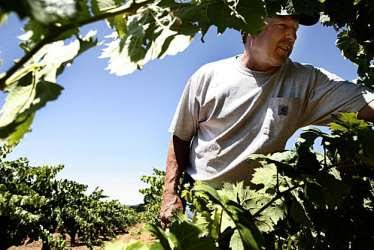
“‘Those guys pretty much planted it themselves back in those days,’ he says. ‘They didn’t hire extra help, so they started the vine from nothing to where it is now. So it’s nice to see them still there, 50 or 60 years later.’”[/i]
Wines featured in the article:
• 2009 Broc Cellars “Naturale” Alexander Valley Carignane
• 2008 Cline “Ancient Vines” Contra Costa County Carignane
• 2008 Clot de l’Oum “La Compagnie des Papillons” Cotes du Roussillon Villages
• 2008 Domaine Anne Gros/Jean-Paul Tollot “Les Carrétals” Minervois
• 2008 Domaine Rimbert Saint-Chinian “Les Travers de Marceau”
• 2007 Lioco “Indica” Mendocino County Red Wine
• 2008 Ridge “Buchignani Ranch” Sonoma County Carignane
\
SF Gate
“Carignane and Beyond: Revitalized Reds”
by Jon Bonné
February 22, 2013
"…While technically a Rhone-native grape, Carignane has an equally long (if not always proud) history in California in the Zinfandel realm, a loyal counterpart that added an edge to the old field blends.
"It has slowly been finding a relevant modern role as table wine, a welcome trend - as there’s finally a dab of glory in making wines that aren’t quite so aspirational.
“Along with some of its lesser-known counterparts, like Counoise, it is finding a modern spot at the table - often thanks to the renewed fortunes of great old-vine plantings. And the generally cooler 2010 and 2011 vintages brought particular nuance to the best examples.”
Wines featured in the article:
• 2011 Neyers “Evangelho Vineyard” Contra Costa County Carignan
• 2011 Lioco “Indica” Mendocino County Red
• 2011 Los Pilares San Diego County Grenache-Carignane
• 2011 Donkey & Goat Mendocino Carignane
• 2011 Broc Cellars “Eagle Point Ranch” Mendocino Counoise
• 2010 Bonny Doon Vineyard “Contra” California Red
I feel a sense of joyful relief in having tasted very few Carignan wines that exhibited the “greenness” that Bonné appears to expect from even great examples of Carignan. Perhaps I have been lucky in my selections. More likely, the increase of Carignan-dominant bottlings on the market has a connection with an improved understanding of what this grape needs to express its potential in the winery.
Kerrigan, begin again. ![]()
Oh, and I think the spelling isn’t optional for this one:
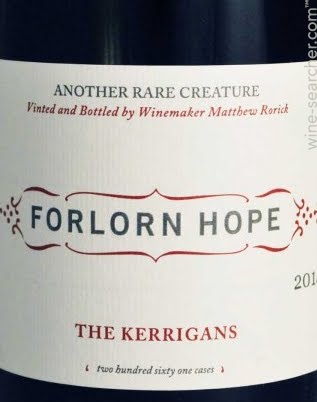
Chris, it’d be a looong walk to California from here!
Plus, TomHill is the one who is always suggesting that a particular variety be “planted up and down the coast”. ![]()
I just need a time machine to rapidly turn newly-planted Carignan vines into 100-year-old ones!!
One of the big hits this past Berserker Day was a Carignan from a small winery sourcing old-vine fruit from Mendocino County’s “Poor Ranch”.
Here is a tasting note from the GrapeLive website:
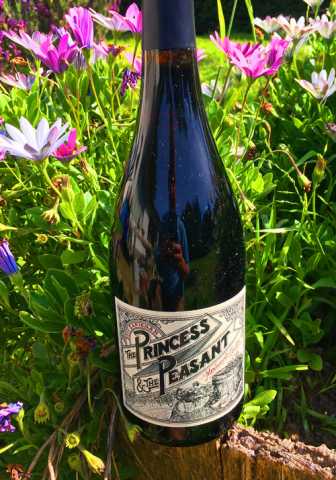
"2015 The Princess & The Peasant, Carignan, Poor Ranch Vineyard, Mendocino County.
“The Poor Ranch Carignan 2015 by Stephanie Rivin, winemaker of Signal Ridge Vineyard, under her Princess & Peasant label is made from 74 year old vines and shows rich detail and ripe juiciness making for an interesting and flavorful wine of joyous California fruit as well as playing homage to the wines of Corbieres. The vintage gave unique concentration and sweet tannins, the tiny berries old these old vines made for a high skin to juicy ratio which adds to the dark nature of this Carignan, while a talented touch in the crafting of this red allows it to be forward and lush, while also delivering balance and graceful depth. Rivin’s Carignan joins a host of other great Carignan based wines that have come out in recent years like Broc Cellars, Pax and Skylark as well as classics like Ridge, and Carignan or Carignane is a grape that has seen a world wide revival, especially in it’s historical sweet spot of Corbieres in France’s Languedoc with the wines of Maxim Magnon and Domaine de Fontsainte standing out in particular! The Princess & The Peasant Poor Ranch Carignan starts with a touch of floral/spicy incense and black fruit and prunes leading to a lively palate of fresh crushed blackberry, sweet black cherry, tangy currant and pomegranate fruits along with mineral/flint, earth, minty notes and wild briar spices. At 13.4% this is not a flabby wine, but medium full on the palate with a silky round mouth feel, while still vibrant and fresh, best to serve slightly chilled so it highlights it’s dry/crisp acidity and especially with hard cheeses, BBQ and Asian/Spicy dishes. Drink this unfined and unfiltered Carignan over the next 2 or 3 years, I love it’s youthful expression, openness and vitality, I highly recommend this wine as well The Princess & The Peasant Pinot Noir, all these new releases from Mendocino’s Signal Ridge Vineyard are seriously fun offerings.
($22 Est.) 92 Points, GrapeLive”
• The Princess and The Peasant homepage
• Mercury News
“Behind Mendocino’s New Princess & the Peasant Wine”
by Mary Orlin
January 4, 2017
The Poor Ranch:
• Mendocino County Wine & Winegrapes website, “Great Wines”: “Poor Ranch” profile
• Mendocino County Wine & Winegrapes website, “Grape Marketplace”: “Poor Ranch” profile
• California Ag Water Stewardship Initiative: “Poor Ranch” profile
Other Producers of Carignan from the “Poor Ranch”:
• Absentee Winery
• Forlorn Hope
• La Onda
• Maître de Chai
• Sans Wine Company
• Subject to Change Wine Company
• Vinca Minor
7x7
“A Once-Forgotten Grape is Reborn in California”
by Louis Villard
November 18, 2013
"If you haven’t heard of the wine grape carignane (carignan in its native France), you’re not alone. But a hundred years ago, it was one of the most widely planted reds in Northern California, primarily in Mendocino. The vine’s high-yielding nature made it popular among growers, which led to a massive overcropping and a low-quality output, used mainly for jug wine. Talk about a grape with a serious image problem.
"But these days, the forgotten fruit is regaining status, thanks to a handful of Bay Area winemakers, who are coaxing stunning results from some of the state’s oldest vines. ‘Carignane was well on its way to extinction,’ says Matt Licklider, co-owner of Lioco in Sonoma, who felt compelled to ‘keep it alive in California.’ Sam and Jessica Bilbro of Sonoma’s Idlewild are also fans. ‘It’s a serious varietal with depth, especially with old vines, yet it’s also juicy and downright delicious,’ Sam explains.
“At its best, carignane can be bold and exciting. The wine combines tart cranberry and cherry flavors with dark chocolate and notes of sage, rosemary, and lavender. It has a naturally high acidity and gritty tannins—imagine the spiciness of syrah, the juiciness of grenache, and the gutsiness of mourvèdre all in one.”
Wines Recommended by the Author:
• 2011 Ridge Carignane, “Buchignani Ranch”
• 2012 Idlewild Carignan, “Testa Vineyard”
• 2012 Donkey & Goat Carignane, Mendocino
• 2011 Wertzberger Carignan, Ruth’s Vineyard
• 2011 Lioco Carignan “Sativa”, Mendocino
Decanter Magazine
“The Rise of Carignan”
by Miguel Hudin
January 1, 2018
"As a wine drinker, to discover (or perhaps rediscover) Carignan is to happen upon a vinous jewel. The fine wines now being produced from this grape are usually the single-vineyard top cuvées in a winery’s portfolio. These are often expensive as a result, but they will also offer a new and exciting experience for anyone looking to broaden their drinking horizons.
"…All in the handling
"Carignan is a tedious grape to grow. Given its large, tight clusters and extremely long maturation cycle, it’s very prone to powdery mildew and bunch rot. It also needs poor, rocky soils and low rainfall to curb yields and increase its flavour concentration. While thousands of hectares exist, it’s the bush-trained old vines that are proving most exciting, as they give miserly yields of 1kg (even 300g) per vine of intensely flavoured grapes.
"…France has invested the most time and learning into understanding the grape. In Gruissan and Embres-et-Castelmaure, INRA (the French National Institute for Agricultural Research) has two vineyard conservatories that hold 233 cuttings taken from vineyards across the country. Overseen by Didier Viguier, they observe the cultivation of Carignan and work on eradicating vine viruses that are often rampant in older vineyards.
"In both Languedoc and Roussillon, there is a tendency to pick Carignan early. Harvests in the third week of September aren’t unheard of and the reasoning is that this preserves flavour, though it seems the thinking is based upon Carignan reaching ideal sugar levels quickly during maturation. Unlike Grenache however, it doesn’t skyrocket in terms of potential alcohol and will stay below 15% in a ‘normal’ vintage, even if allowed to ripen longer.
"With Carignan originating very near Catalonia, the winemakers there have been accustomed to it for centuries. The lengthy ripening avoided by the French is embraced by the Catalans and continues to be common, running into October or even early November for certain years and parcels. This makes for two very different profiles of the grape.
"…Time to shine
"Carignan is known for developing a wealth of tannins, acidity and colour, so it has typically been used as an excellent blending partner for Grenache, which can be lacking in these qualities. If not made with care, however, it can also be prone to rampant reduction during vinification. So, while a beautiful grape on its own, the wine must still be made carefully.
"At their best, whether north or south of the Pyrenees, Carignan wines will usually display dark cherry fruit, blueberries, violet and other floral aromas along with notes of orange peel, black liquorice and cocoa. On the palate, the wines are very full-bodied with tannins that have a fine, dusty aspect and an acidity that presents a fresh and lively wine with excellent potential for ageing.
"…The past 15 years of Carignan’s evolution haven’t come about by accident as a new generation has either opened new cellars or taken over from their parents. They’ve studied oenology instead of just inheriting the knowledge from their forefathers and are able to graft modern winemaking onto the old methods, which has in turn thrust this grape upon the world stage.
"Just a few years ago, there was no thought that beautiful, complex wines might have been made from the Carignan grape, given its often thin profile when grown in Languedoc-Roussillon, or the rough abrasiveness in examples from Catalonia.
“While it’s true that this kind of evolution is happening with countless grape varieties when given a splash of modernity, in the case of Carignan it has also meant waiting more than a century for old vines to shed their rustic past and be reborn in splendour.”
The author of the above Decanter article spent a considerable amount of verbiage in distilling the elements of the final product. Here is one of those preparatory pieces…
Vila Viniteca
“How to Fall in Love with Carignan”
by Miguel Hardin
December 12, 2017
"…When talking about local red grapes: Grenache is exhilarating and beautiful, Trepat is most definitely rising, and Monastrell has its merits. I’ve also tasted luscious wines of grapes that were once upon a time only known to be good in France (Cabernet Sauvignon, Merlot, Syrah, etc.) But for some reason Carignan holds a fascination I’ve not had for other grapes, perhaps because of how ignorant I was of it before moving to Catalunya, or perhaps because its profile is just so unknown to Americans. When I do private tastings for visitors, they come under its sway as well however, becoming full, Carignan Converts.
"For a forthcoming article, the editor of Decanter, one of the magazines I contribute to commissioned a piece specifically about Carignan. Due to this, I’ve been tasting wines and talking to people from as far south as Terra Alta and as far north as the Rhône Valley to get at what makes this grape so unique and appealing or, for those who have known it in the past, so despised.
"If there is any reputation that Carignan has had, it’s one of poor quality wine. We can thank large French producers for that as the vines north of the Pyrenees were pushed to do what Carignan can do easily which is to overproduce. They were seeing production output of 200 hl/ha which by way of comparison is nearly 300% more than the legal limits of DOs Empordà, Montsant, & Terra Alta and 500% percent more than DOQ Priorat!
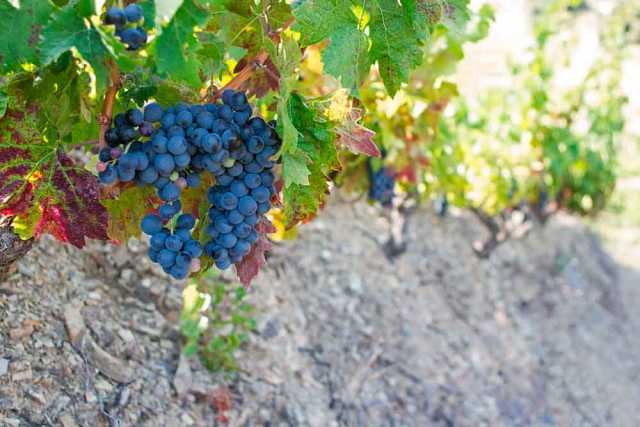
"It’s no wonder it’s been seen as a thin, unappealing wine when this is the desired use of the grape. It’s as if a person were made to do manual labor for 7 days straight with no break. How much personality would they possibly be able to have after being stretched so thin?
"The secret to a spellbinding Carignan is the same in Spain as it is in France which is to have small production. In those four DOs of Empordà, Priorat, Montsant, and Terra Alta, it’s there that you find old bush vines struggling to produce even 1kg of grapes and at times as little as 300g. This concentration at the vine makes for grapes of stellar quality and it’s only then that the wealth of acidity, fine tannins, dusty plum, and cocoa notes of the best Carignans come forth.
“Now it needs to be said that low-production vines are just one part of the equation. While they can produce a nice wine, it will fall short if the winemaking is not at the same level of the grapes. In fact, reduction, that stinky Sulphur smell, rears its head quite easily if Carignan isn’t managed during fermentation. Once sound viticulture is matched with wise vinification you can see the weight of the grape tamed into a wondrous, nuanced wine that glides across your senses with wave upon wave of flavor and depth…”[/i]
*** Wines Tasted Omitted for Space (link) ***
”…I have to say that it’s less an issue of ‘the best’ but that there are two very different styles between France and Spain. In France, they pick much earlier…"
"When picked earlier, you do get a wine that’s less alcoholic, more acidic, and definitely more appealing to many people. I’m not a fan of picking Carignan early as shown by some old-vine Carignan I recently tasted from my native California (yes, we have old vines there for the same reason as here in that the grape could produce an ungodly number of grapes) and the winemaker had picked at the end of August in 2016, sadly. The result was, ‘different’ to say the least, especially when compared to another wine made from an adjoining plot that was picked at the end of September that reached a level similar to what we see in Catalunya.
“Worrying about alcohol levels can’t be your main premise in winemaking as when Carignan is grown upon poor soils, especially those of slate found in Priorat or Empordà this appears to mitigate the issues of the alcohol…making a more ‘rounded’ wine. To me, Carignan enjoys lengthy ripening to be at its best although I have to admit that when picked earlier, it’s more food friendly…”
“…I worry that if an explosion in popularity happens, these old, rare plots where the grapes for the best wines are sourced will ‘Burgundize’, fetching prices that will be far beyond the reach of my admittedly lethargic wallet…if fame and worth are given back to this once-scorned grape, it certainly won’t be a bad thing. This may even encourage others to produce lovely varietal Carignan wines in the future which is a much more pleasant thought than the other option…which was simply to tear out these old precious vines…”
That guy Abe something of Scholium was making some carignan bottlings from Southern France in his Clos Thales project. Pretty dense and differentiated…although doubt the flavors would be universally appealing.
Not sure you can call it a renaissance when the grape was never popular in the first place.
I’ve had it in a southern Rhone blend (Albin Jacumin CdR Les Bédines, a GSC - Grenache, Syrah, Carignan) and liked the result quite a bit. In fact I cracked one last night!
That has always been its role until recently. It has been considered a blending grape.
Now a few wineries are trying it out on its own, with variable results.
I would say that’s an accurate sentiment with a lot of different varieties these days.
Right. Lots of folks are experimenting, as the Cabernet/Chardonnay field is pretty well saturated.
There are princes to be found, but sometimes a few frogs.
“Some of the best Carignan” that MTP of Bedrock Wine Company had seen - as of 2009. ![]()
“Lorenzo’s Vineyard” video highlight by “Bedrock Cinema” on YouTube…
Video of Vinca Minor’s Harvest of “Rosewood Vineyard’s” 85-year-old Mendocino County Carignan:
Mendocino County’s “Rosewood Vineyard”:
• Profile on Mendocino Wine & Winegrapes website:
• Jenny & Francois Selections portfolio, Vinca Minor “Rosewood Vineyard” Carignan:
“› Age of Vines: 85 years old
› Soil: Redvine, red clay strewn with fist sized rocks
› Varieties: Carignan
› Viticulture: ‘Rosewood Vineyards’ is farmed organically by a couple who have been on the property for over four generations.”
• Vinca Minor website:
FWIW I tried a Maxime Magnon Corbières Rouge “Campagnès” (2015 I believe) about 6 months ago as I was gifted a bottle after a tasting - very promising, so recommend to try it if you can. It’s predominantly Carignan based.

